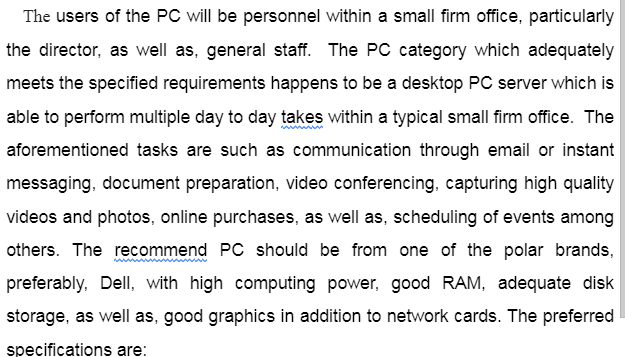Case Study Review-Case Study- Director’s Request for PCs using MS Word Table, MS Access, and MS PowerPoint
Case Study – Using MS Office 2010 / 2013 / 365
Please use the document “READ FIRST – Case Study Instructions – Director’s Requirements” for each of the parts described below.
Part 1: Specifications Table (MS Word)
Use the project description HERE to complete this activity. For a review of the complete rubric used in grading this exercise, click on the Assignments tab, then on the title Case Study Part 1 – PC Specs (Word)– click on Show Rubrics if the rubric is not already displayed.
For the case study provided to you, create MS Word tables that identify and contain the hardware and software requirements to meet the director’s requirements. The MS Word document in its final form will include 6 MS Word tables. It will include a two-paragraph narrative summary that classifies the user type and identifies the PC category that will be recommended. The specific instructions are found in the table at the end of this file.
Students are expected to conduct external research to adequately address all aspects of the assignment requirements. It is suggested that students use a computer manufacturer’s site (i.e., Apple, Dell, Toshiba) to help in identifying all the components needed to meet the director’s requirements. Remember, although there are 5 computers to be purchased, you are required to configure only one, as the same one may be purchased for all 5 employees. Any outside sources should be correctly cited in APA style at the end of the table.Students will need to include specific requirements from the case study to show why each item is being recommended. Each element listed below must be incorporated into the assignment. Omissions will result in loss of points.
Make and model and description are required, when at all possible.. For example, if the solution suggested is a 32” IBM Monitor, say so. Do not just say monitor because that does not provide sufficient information for a purchase. It is not necessary, for example, to identify the make and model of a USB port.
You must also consider components that may be a part of a machine or device. For example, the System Unit table will require elements such as USB ports. The monitor and mouse are typically separate devices on a desktop, but on a laptop or tablet they are often integrated. You should identify the various forms of input and output for your computer(s) on the Hardware table, whether they are separate devices or integrated elements.
There should be sufficient detail in this case study for procurement/purchasing personnel to buy the systems. Details are crucial.
Don’t focus on web references as to where the equipment can be found, although you may include your source(s). Focus on a solution to specific requirements.
Do not ‘number’ requirements in your table, even though they are numbered in the “Case Study – Director’s Requirements’ document. In many cases there are several requirements expressed in a single numbered listing. It’s important that you are clear about which requirement is addressed by a specific piece of hardware or software.
All identified hardware and software and relevant requirements must be listed in the tables. Mentioning an item or a requirement in the two paragraph narrative is perfectly ok, but it must also be in the tables.
Answer Review-Case Study Review

